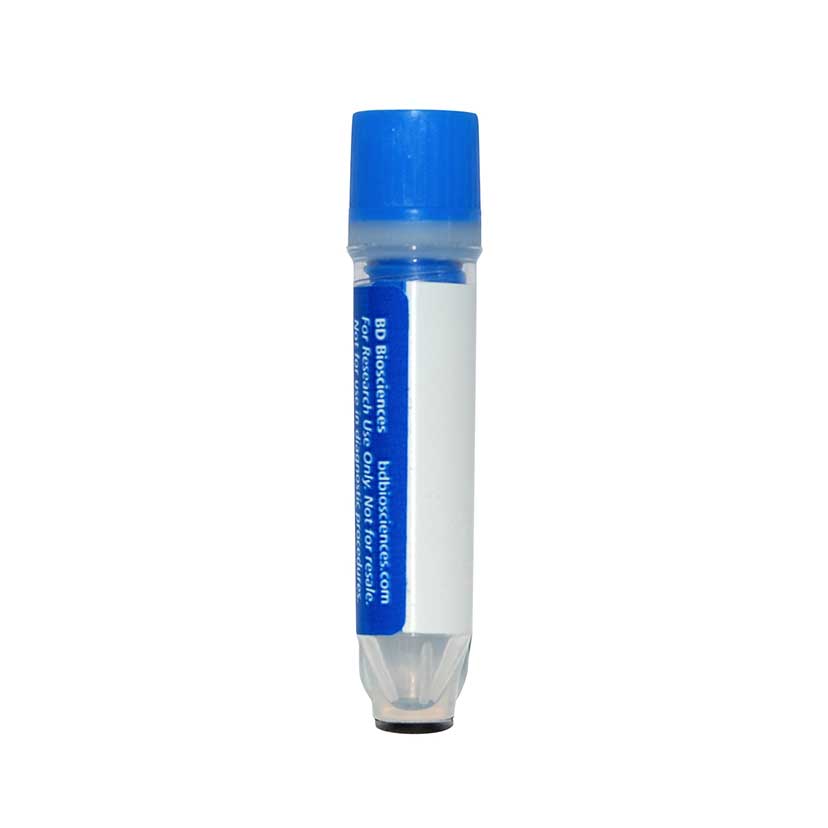Old Browser
Looks like you're visiting us from {countryName}.
Would you like to stay on the current location or be switched to your location?
BD™ AbSeq Oligo Rat Anti-Mouse CD137
Clone 1AH2 (RUO)


규제 상태 범례
Becton, Dickinson and Company의 명시적인 서면 승인 없이는 사용 하실 수 없습니다.
준비 및 보관
권장 분석 절차
Put all BD® AbSeq Reagents to be pooled into a Latch Rack for 500 µL Tubes (Thermo Fisher Scientific Cat. No. 4900). Arrange the tubes so that they can be easily uncapped and re-capped with an 8-Channel Screw Cap Tube Capper (Thermo Fisher Scientific Cat. No. 4105MAT) and the reagents aliquoted with a multi-channel pipette.
BD® AbSeq tubes should be centrifuged for ≥ 30 seconds at 400 × g to ensure removal of any content in the cap/tube threads prior to the first opening.
제품 고시
- This reagent has been pre-diluted for use at the recommended volume per test. Typical use is 2 µl for 1 × 10^6 cells in a 200-µl staining reaction.
- The production process underwent stringent testing and validation to assure that it generates a high-quality conjugate with consistent performance and specific binding activity. However, verification testing has not been performed on all conjugate lots.
- Please refer to bd.com/genomics-resources for technical protocols.
- Caution: Sodium azide yields highly toxic hydrazoic acid under acidic conditions. Dilute azide compounds in running water before discarding to avoid accumulation of potentially explosive deposits in plumbing.
- Source of all serum proteins is from USDA inspected abattoirs located in the United States.
- Illumina is a trademark of Illumina, Inc.
- Please refer to http://regdocs.bd.com to access safety data sheets (SDS).
- For U.S. patents that may apply, see bd.com/patents.
관련 제품






The 1AH2 monoclonal antibody specifically binds to CD137. CD137 is a member of the TNFR/NGFR superfamily that is likewise known as Tnfrsf9, 4-1BB, Ly-63, or ILA. Monomers or multimeric forms of CD137 are expressed, upon activation, on the surface of splenic T lymphocytes, thymocytes, intestinal intraepithelial T lymphocytes (IEL), and some T cell lines and clones. While stimulating T cells by IL-2, IL-4, or anti-CD28 alone does not result in the expression of CD137; addition of IL-2, IL-4, anti-CD28, or syngeneic accessory cells to splenic T cells stimulated via TCR/CD3 can result in a high level CD137 expression. CD137 is also reportedly expressed on IL-2 activated NK cells, but not on freshly isolated NK cells. CD137 physically associates with p56 [lck] through a Cys-Arg-Cys-Pro binding site in its cytoplasmic domain; the same motif in the cytoplasmic tail of the CD4 and CD8a molecules is responsible for association with p56 [lck]. A signaling function for the CD137 molecule in mouse T cells is indicated by reports in which cross-linking of CD137 with 1AH2 mAb resulted in enhanced proliferation of CD3e-activated splenic T cells and IEL and in enhanced cytolytic activity of IEL in response to immobilized anti-CD3e. In addition to extracellular matrix proteins which bind to CD137, the CD137L (4-1BBL) serves as a ligand for CD137. This molecule has also been detected on LPS-activated macrophages, and anti-IgM antibody-activated splenic B cells. Interaction between T and B cells through CD137/CD137L is reported to play a role in antigen presentation, further supporting a costimulatory role for CD137 in the immune response of T lymphocytes.
개발 참고 자료 (11)
-
Chalupny NJ, Peach R, Hollenbaugh D, Ledbetter JA, Farr AG, Aruffo A. T-cell activation molecule 4-1BB binds to extracellular matrix proteins. Proc Natl Acad Sci U S A. 1992; 89(21):10360-10364. (Biology). 참조 보기
-
DeBenedette MA, Chu NR, Pollok KE, et al. Role of 4-1BB ligand in costimulation of T lymphocyte growth and its upregulation on M12 B lymphomas by cAMP. J Exp Med. 1995; 181(3):985-992. (Biology). 참조 보기
-
DeBenedette MA, Shahinian A, Mak TW, Watts TH. Costimulation of CD28- T lymphocytes by 4-1BB ligand. J Immunol. 1997; 158(2):551-559. (Biology). 참조 보기
-
Hurtado JC, Kim SH, Pollok KE, Lee ZH, Kwon BS. Potential role of 4-1BB in T cell activation. Comparison with the costimulatory molecule CD28. J Immunol. 1995; 155(7):3360-3367. (Biology). 참조 보기
-
Hurtado JC, Kim YJ, Kwon BS. Signals through 4-1BB are costimulatory to previously activated splenic T cells and inhibit activation-induced cell death. J Immunol. 1997; 158(6):2600-2609. (Biology). 참조 보기
-
Kim YJ, Pollok KE, Zhou Z, et al . Novel T cell antigen 4-1BB associates with the protein tyrosine kinase p56lck1. J Immunol. 1993; 151(3):1255-1262. (Biology). 참조 보기
-
Pollok KE, Kim SH, Kwon BS. Regulation of 4-1BB expression by cell-cell interactions and the cytokines, interleukin-2 and interleukin-4. Eur J Immunol. 1995; 25(2):488-494. (Biology). 참조 보기
-
Pollok KE, Kim YJ, Zhou Z, et al. Inducible T cell antigen 4-1BB. Analysis of expression and function. J Immunol. 1993; 150(3):771-781. (Immunogen). 참조 보기
-
Saoulli K, Lee SY, Cannons JL, et al. CD28-independent, TRAF2-dependent costimulation of resting T cells by 4-1BB ligand. J Exp Med. 1998; 187(11):1849-1862. (Biology). 참조 보기
-
Takeda K, Oshima H, Hayakawa Y, et al. CD27-mediated activation of murine NK cells. J Immunol. 2000; 164(4):1741-1745. (Biology). 참조 보기
-
Zhou Z, Pollok KE, Kim KK, Kim YJ, Kwon BS. Functional analysis of T-cell antigen 4-1BB in activated intestinal intra-epithelial T lymphocytes. Immunol Lett. 1994; 41(2-3):177-184. (Biology). 참조 보기
Please refer to Support Documents for Quality Certificates
Global - Refer to manufacturer's instructions for use and related User Manuals and Technical data sheets before using this products as described
Comparisons, where applicable, are made against older BD Technology, manual methods or are general performance claims. Comparisons are not made against non-BD technologies, unless otherwise noted.
For Research Use Only. Not for use in diagnostic or therapeutic procedures.